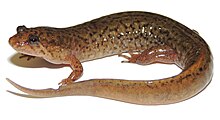| Desmognathus fuscus | |
|---|---|

| |
| Scientific classification | |
| Domain: | Eukaryota |
| Kingdom: | Animalia |
| Phylum: | Chordata |
| Class: | Amphibia |
| Order: | Urodela |
| Family: | Plethodontidae |
| Subfamily: | Plethodontinae |
| Genus: | Desmognathus |
| Species: | D. fuscus
|
| Binomial name | |
| Desmognathus fuscus (Rafinesque, 1820)
| |

| |
| Range of D. fuscus | |
| Synonyms[2] | |
| |
Desmognathus fuscus is a species of amphibian in the family Plethodontidae (lungless salamanders).[2][3] The species is commonly called the dusky salamander or northern dusky salamander to distinguish it from populations in the southern United States which form several distinct species, the southern dusky salamanders (D. auriculatus, D. valentinei).[3] The northern dusky salamander is the most widespread representative of its genus in Canada.[3] It can be found in eastern North America from extreme eastern Canada in New Brunswick south to South Carolina.[3][1][4] The size of the species' total population is unknown, but is assumed to easily exceed 100,000.[3][1] The species' habitat differs somewhat geographically; dusky salamanders in the northern part of the range prefer rocky woodland streams, seepages, and springs, while those in the south favor floodplains, sloughs, and muddy places along upland streams.[3][1][4][5] They are most common where water is running or trickling.[3][1] They hide under various objects, such as leaves or rocks, either in or near water. Alternatively, they may enter burrows for protection.[3][4] The dusky salamander lays its eggs close to water under moss or rocks, in logs, or in stream-bank cavities. The larval stage which follows is normally aquatic.[3][4]
- ^ a b c d e Geoffrey Hammerson (2004). "Desmognathus fuscus". IUCN Red List of Threatened Species. 2004: e.T59249A11906400. doi:10.2305/IUCN.UK.2004.RLTS.T59249A11906400.en. Retrieved 16 November 2021.
- ^ a b Cite error: The named reference
Frostwas invoked but never defined (see the help page). - ^ a b c d e f g h i Cite error: The named reference
COSEWICwas invoked but never defined (see the help page). - ^ a b c d Cite error: The named reference
Ontario Naturewas invoked but never defined (see the help page). - ^ Cite error: The named reference
Hom 1988was invoked but never defined (see the help page).
